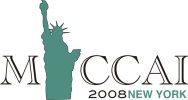Computational Biomechanics for Medicine III
A MICCAI 2008 Workshop, September 10 2008
Home | Organisers | Important
Dates | Scope | Registration
| Submissions
Rationale:
Mathematical modelling and computer simulation have proved tremendously
successful in engineering. One of the greatest challenges for mechanists is to
extend the success of computational mechanics to fields outside traditional
engineering, in particular to biology, biomedical sciences, and medicine. The
proposed workshop will provide an opportunity for computational biomechanics
specialists to present and exchange opinions on the opportunities of applying
their techniques to computer-integrated medicine. For example, continuum mechanics
models provide a rational basis for analysing biomedical images by constraining
the solution to biologically reasonable motions and processes. Biomechanical
modelling can also provide clinically important information about the physical
status of the underlying biology, integrating information across molecular,
tissue, organ, and organism scales. The main goal of this workshop is to
showcase the clinical and scientific utility of computational biomechanics in
computer-integrated medicine.
The authors of the best papers presented at the Computational Biomechanics for
Medicine workshop will be requested to submit an extended version of their
papers to the special section of the Medical Image Analysis journal.
Program (provisional)
Invited
lectures are planned for 40 min + 20 min discussion
Podium
presentations are planned for 20 min + 10 min discussion
7.30-8.00 Registration
08.00-08.10 Opening remarks (Karol Miller)
Stream 1. Computational biomechanics of soft tissues
8.10 – 9.10 Invited
Lecture 1: Molecular and Cellular
Biomechanics-based Insights into the Pathophysiology of Human Diseases
Chwee Teck LIM
9.10 – 9.40 Cardiac
motion estimation using multi-scale feature points
Becciu A; van
Assen H; Florack L; Janssen B; ter Haar Romeny B
9.40
– 10.10 Fast
image-based model of mitral valve closure for surgical planning
Hammer P;
Vasilyev N; Perrin D; del Nido P; Howe R
10.10 – 10.30 Coffee break
10.30-11.00 Multimodal
Registration of White Matter Brain Data via Optimal Mass Transport
Rehman,
Tauseef; Haber, Eldad; Pohl, Kilian; Haker, Steven; Halle, Mike; Talos, Florin;
Wald, Lawrence; Kikinis, Ron; Tannenbaum, Allen
11.00-11.30 Cardiac Motion Recovery by Coupling an Electromechanical Model and Cine-MRI Data: First Steps
Billet F;
Sermesant M; Delingette H; Ayache N
11.30-12.00 Comparison of
Displacement-Based and Force-Based Mapped Meshing
Magnotta V.A, Li W, Grosland N.M.
12.00 – 13.00 Lunch and registration
13.00 – 14.00 Poster Session
Nonlinear Elastic
Registration with Unbiased Regularization in Three Dimensions
Yanovsky I;
Le Guyader C; Leow A; Thompson P; Vese L
Coupling Finite Element and Mesh-free Methods for Modelling Brain Deformation in Response to Tumour Growth
Berger, Jamie; Horton, Asley; Joldes, Grand; Wittek
Simulation of Active Cardiac Dynamics with Orthotropic Hyperelastic Material Model
Wong, Ken C.L.; Wang, Linwei;
Zhang, Heye; Liu, Huafeng; Shi, Pengcheng
Realistic And Efficient Brain-Skull Interaction Model For Brain Shift Computation
Joldes, Grand Roman; Wittek, Adam;
Miller, Karol; Morriss,
Jonathan Vappou, Ioannis Zervantonakis, Jianwen Luo, and Elisa Konofagou
Stream 2.
Computational biomechanics of tissues of musculoskeletal system
14.00 – 15.00 Invited
Lecture 2: Computation Biomechanics: Neuromuscular skeletal modelling to estimate
tissue loading in the lower limbs
David
Lloyd
15.00 – 15.30 Coffee break
15.30 – 16.00 Assessment of
Peri-Articular Implant Fitting Based on Statistical Finite Element Modeling
Bonaretti S;
Reimers N; Reyes M; Nikitsin A; Joensson A; Nolte L
16.00 – 16.30 Orientation
definition of anisotropy is important to finite element simulation of bone material properties
16.30 – 16.40 Close
